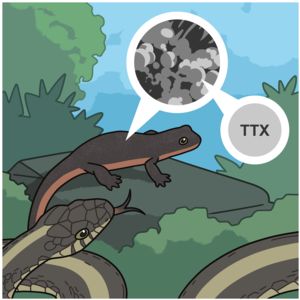The BEACON, the bacteria and the rough-skinned newt
The textbook example in ecology, literally, goes like this: The poisonous rough-skinned newt and the garter snake are locked in an evolutionary arms race. The more resistant the snake becomes to the newt's neurotoxic defense, the more deadly toxin the newt produces in some newts, enough to kill two dozen humans.

But in a study published in the open-access journal eLife, Michigan State University Ecology, Evolution and Behavior graduate Patric Vaelli, now conducting postdoctoral studies at Harvard, just made the story of the rough-skinned newt a lot more complex.
It turns out the arms race has an invisible, and highly influential, third party: neurotoxin-producing bacteria living on the newt's skin.
Seven years ago, NatSci's Heather Eisthen, a neuroethologist in the MSU Department of Integrative Biology and Vaelli's future advisor, gave a presentation at the BEACON Center for the Study of Evolution in Action.
"I was giving a talk about rough-skinned newts charming, but deadly poisonous amphibians loaded with the neurotoxin tetrodotoxin (TTX)," said Eisthen, who has studied evolutionary changes in animal nervous systems and behavior at MSU for more than 23 years. "I explained that no one had ever identified the source of TTX on newts."
Vaelli came to MSU as a graduate student in Eisthen's lab around the same time, and the environment was perfect for cultivating the study. MSU is world-renowned for microbial ecology and evolution, from Richard Lenski's E. coli Long-term Experimental Evolution Project to the digital, evolving organisms of Charles Ofria, who helped land the National Science Foundation grant that founded the BEACON Center.
Vaelli's search for the source of the newts' TTX germinated with Eisthen's talk and grew with the help of two initial grants from the BEACON Center.
Read more at MSU Today.



